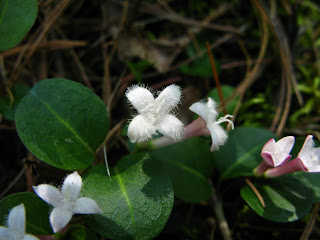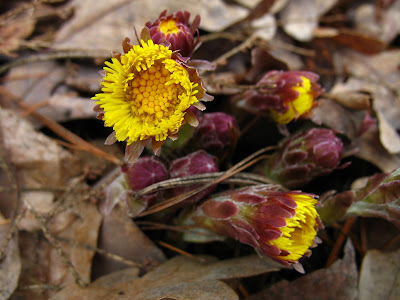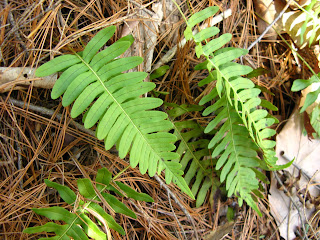What a difference the sun makes! Here's a photo of the sunny side of Mud Pond three days ago: all warm and dry, the ice receded far from shore (today it was all gone, except for a little bay at the shaded south end). Nice!

And here's a photo of the shady side of Moreau Lake today: shin-deep in snow, with ice still gripping the shore. Brrrrr! So where do you think I decided to walk today? That's right, I headed right back to Mud Pond.

What a change in the shoreline from three days ago! Instead of clear water that let me take photos of suspended newts and bottom-basking tadpoles, the surface near shore was coated with foamy brown scum and awash with heaps of dead plant matter. The wriggling newts set the whole mess a-roil as I passed, although I couldn't really see them through the murk. A massive turnover must have occurred, the sun-warmed top layer of water mixing with the icy-cold layers below, bringing up all the gunk that had lain on the bottom all winter. I wonder how long it will take to clear up again?
All kinds of seasonal stuff is going on right now. Walking a sunny, sandy path, I was startled by clouds of bees at my feet. Yikes! I thought, am I about to get stung? But the bees paid me no attention. Looking more closely, I noticed that many were busy digging holes in the soft sand. Ah yes, these must be the ground bees Curt Stager wrote about in his book Field Notes from the Northern Forest. These are solitary, rather than hive-dwelling social bees. There's no queen to defend, so no soldier bees try to sting you in her defense. Each female digs her own nest, which she coats with a substance that looks like brown cellophane (it's actually polyester!). She spends the summer packing this pouch with pollen, lays her own egg in there, then seals it all up in a little packet. At some point the egg hatches, the larva eats the pollen, then pupates, and when spring arrives, the adult digs its way to the surface. The bees buzzing around my feet must have been the newly emerging generation. (Sorry. They wouldn't sit still for a picture.)
Who says there's nothing new under the sun? I'd never seen these bees before. Nor noticed a pond turn over. I've often been asked why I visit the same places day after day. Don't I ever get bored? No, I don't. Because they're never the same.















































